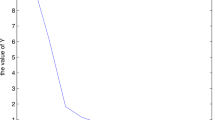Abstract
We consider a reformulation of mathematical programs with complementarity constraints, where by introducing an artificial variable the constraints are converted into equalities which are once but not twice differentiable. We show that the Lagrange optimality system of such a reformulation is semismooth and BD-regular at the solution under reasonable assumptions. Thus, fast local convergence can be obtained by applying the semismooth Newton method. Moreover, it turns out that the squared residual of the Lagrange system is continuously differentiable (even though the system itself is not), which opens the way for a natural globalization of the local algorithm. Preliminary numerical results are also reported.
Similar content being viewed by others
References
Billups, S.C.: Algorithms for complementarity problems and generalized equations. Tech. report 95–14 and Ph.D. thesis, Computer Sciences Department, University of Wisconsin, Madison (1995)
De Luca, T., Facchinei, F., Kanzow, C.: A theoretical and numerical comparison of some semismooth algorithms for complementarity problems. Comput. Optim. Appl. 16, 173–205 (2000)
Dolan, E., Moré, J.: Benchmarking optimization software with performance profiles. Math. Program. 91, 201–213 (2002)
Facchinei, F., Pang, J.-S.: Finite-Dimensional Variational Inequalities and Complementarity Problems. Springer, New York (2003)
Facchinei, F., Soares, J.: A new merit function for nonlinear complementarity problems and a related algorithm. SIAM J. Optim. 7, 225–247 (1997)
Fletcher, R., Leyffer, S.: Solving mathematical programs with equilibrium constraints as nonlinear programs. Optim. Methods Softw. 19, 15–40 (2004)
Fletcher, R., Leyffer, S., Ralph, D., Scholtes, S.: Local convergence of SQP methods for mathematical programs with equilibrium constraints. SIAM J. Optim. 17, 259–286 (2006)
Izmailov, A.F., Solodov, M.V.: Superlinearly convergent algorithms for solving singular equations and smooth reformulations of complementarity problems. SIAM J. Optim. 13, 386–405 (2002)
Izmailov, A.F., Solodov, M.V.: An active-set Newton method for mathematical programs with complementarity constraints. SIAM J. Optim. 19, 1003–1027 (2008)
Izmailov, A.F., Solodov, M.V.: On attraction of Newton-type iterates to multipliers violating second-order sufficiency conditions. Math. Program. 117, 271–304 (2009)
Jiang, H.: Global convergence analysis of the generalized Newton and Gauss–Newton methods of the Fischer–Burmeister equation of the complementarity problem. Math. Oper. Res. 24, 529–543 (1999)
Kanzow, C., Kleinmichel, H.: A new class of semismooth Newton-type methods for nonlinear complementarity problems. Comput. Optim. Appl. 11, 227–251 (1998)
Kojima, M., Shindo, S.: Extensions of Newton and quasi-Newton methods to systems of PC 1 equations. J. Oper. Res. Soc. Jpn. 29, 352–374 (1986)
Kummer, B.: Newton’s method for nondifferentiable functions. In: Guddat, J., Bank, B., Hollatz, H., Kall, P., Klatte, D., Kummer, B., Lommalzsch, K., Tammer, L., Vlach, M., Zimmerman, K. (eds.) Advances in Mathematical Optimization, vol. 45, pp. 114–125. Akademie-Verlag, Berlin (1988)
Kummer, B.: Newton’s method based on generalized derivatives for nonsmooth functions. In: Oettli, W., Pallaschke, D. (eds.) Advances in Optimization, pp. 171–194. Springer, Berlin (1992)
Leyffer, S.: MacMPEC: AMPL collection of mathematical programs with equilibrium constraints. http://wiki.mcs.anl.gov/leyffer/index.php/MacMPEC
Luo, Z.-Q., Pang, J.-S., Ralph, D.: Mathematical Programs with Equilibrium Constraints. Cambridge Univ. Press, Cambridge (1996)
Mifflin, R.: Semismooth and semiconvex functions in constrained optimization. SIAM J. Control Optim. 15, 959–972 (1977)
Nocedal, J., Wright, S.J.: Numerical Optimization, 2nd edn. Springer, New York (2006)
Outrata, J.V., Kocvara, M., Zowe, J.: Nonsmooth Approach to Optimization Problems with Equilibrium Constraints: Theory, Applications and Numerical Results. Kluwer Acad. Publ., Boston (1998)
Pang, J.S., Qi, L.: Nonsmooth equations: Motivation and algorithms. SIAM J. Optim. 3, 443–465 (1993)
Qi, L.: Convergence analysis of some algorithms for solving nonsmooth equations. Math. Oper. Res. 18, 227–244 (1993)
Qi, L., Sun, J.: A nonsmooth version of Newton’s method. Math. Program. 58, 353–367 (1993)
Ralph, D.: Sequential quadratic programming for mathematical programs with linear complementarity constraints. In: Computational Techniques and Applications: CTAC95, pp. 663–668. World Scientific, Singapore (1996)
Ralph, D., Wright, S.J.: Some properties of regularization and penalization schemes for MPECs. Optim. Methods Softw. 19, 527–556 (2004)
Scheel, H., Scholtes, S.: Mathematical programs with complementarity constraints: stationarity, optimality and sensitivity. Math. Oper. Res. 25, 1–22 (2000)
Scholtes, S.: Convergence properties of a regularization scheme for mathematical programs with complementarity constraints. SIAM J. Optim. 11, 918–936 (2001)
Stein, O.: Lifting mathematical programs with complementarity constraints. Math. Program. (2010). doi:10.1007/s10107-010-0345-y
Author information
Authors and Affiliations
Corresponding author
Additional information
Research of the first two authors is supported by the Russian Foundation for Basic Research Grant 10-01-00251. The third author is supported in part by CNPq Grants 300513/2008-9 and 471267/2007-4, by PRONEX–Optimization, and by FAPERJ.
Rights and permissions
About this article
Cite this article
Izmailov, A.F., Pogosyan, A.L. & Solodov, M.V. Semismooth Newton method for the lifted reformulation of mathematical programs with complementarity constraints. Comput Optim Appl 51, 199–221 (2012). https://doi.org/10.1007/s10589-010-9341-7
Received:
Published:
Issue Date:
DOI: https://doi.org/10.1007/s10589-010-9341-7




